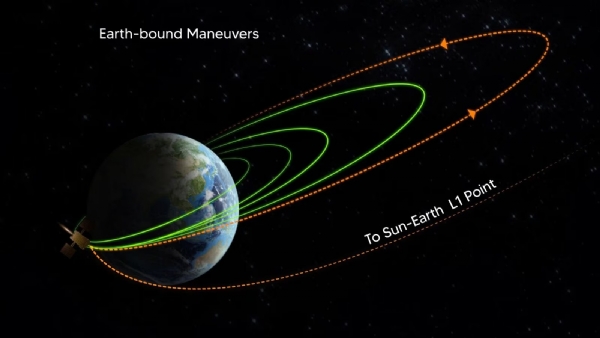'Off to Sun-Earth L1 Point': India's First Solar Mission Aditya L1 bound for pivotal location
19 Sep 2023 14:54:44
India’s first solar mission, Aditya L1, got a “send-off" from the Earth after the completion of the fourth and final Earth-bound manoeuver in the early hours of Tuesday.
The Trans-Lagrangian Point 1 Insertion (TL1I) manoeuvre is the beginning of the spacecraft’s 110-day trajectory to its designated destination of L1 — Lagrange point — a location with gravitational balance between the Earth and the Sun.

The Indian Space Organisation (ISRO) took to the microblogging site X and said, “Off to Sun-Earth L1 point! The Trans-Lagrangian Point 1 Insertion (TL1I) manoeuvre is performed successfully. The spacecraft is now on a trajectory that will take it to the Sun-Earth L1 point. It will be injected into an orbit around L1 through a maneuver after about 110 days."
The space agency said that this is its fifth consecutive time of successfully transferring an object on a trajectory toward another celestial body or location in the space.
India’s first space-based observatory, Aditya L1 will study the sun from a halo orbit around first Sun-Earth Lagrangian point (L1) located at a distance of about 1.5 million km from Earth, which is about one per cent of the Earth-Sun distance.
Aditya-L1 will study the outer atmosphere of the Sun and the solar body is a giant sphere of gas. The spacecraft won’t move any closer to the Sun and neither will it land on its surface. The satellite will spend its entire mission life orbiting around L1, in an irregularly shaped orbit in a plane which will be approximately perpendicular to the line joining the Earth and the Sun.
The spacecraft carries seven different payloads to study the Sun, four of which will observe the light from the Sun and the remaining three will measure in situ parameters of the plasma and magnetic fields.
The payloads were indigenously developed by ISRO and national research laboratories including Indian Institute of Astrophysics (IIA), Bengaluru, and Inter University Centre for Astronomy and Astrophysics (IUCAA).
Aditya-L1 was successfully injected into an elliptical orbit of 235×19500 km around the earth after its flight duration of 63 minutes and 20 seconds that day.
A spacecraft placed in the halo orbit around the L1 point has a major advantage of getting a continuous view of the Sun without any eclipses. This will prove as a benefit in observing the sun’s activities and its effect on space weather in real time.
The spacecraft’s payloads will make observations using electromagnetic and particle and magnetic field detectors.
Using the special vantage point L1, four payloads directly view the Sun and the other three payloads carry out in-situ studies of particles and fields at the Lagrange point L1. The tools on board will provide us with a vast range of data, including insights into the Sun’s magnetic field, its outermost layer, the corona and its emissions.